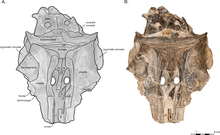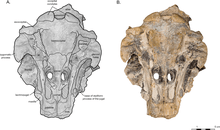Allodelphis
Allodelphis is an extinct genus of whale belonging to Allodelphinidae found in marine deposits of the eastern North Pacific.
| Allodelphis | |
|---|---|
 | |
| A. pratti holotype skull shown from above | |
| Scientific classification | |
| Kingdom: | Animalia |
| Phylum: | Chordata |
| Class: | Mammalia |
| Order: | Artiodactyla |
| Infraorder: | Cetacea |
| Family: | †Allodelphinidae Barnes, 2006 |
| Genus: | †Allodelphis Wilson, 1935 |
| Species | |
| |
Description

Allodelphis has a very elongated rostrum and a polydont, heterodont dentition. It differs from Ninjadelphis and Zarhinocetus in the following characters: wider dorsal opening of mesorostral canal anterior to dorsal nares, posterior part of rostrum anterior to dorsal nares not depressed, posterior ends of premaxillae less irregular and digitated, posterior ends of premaxillae extending posteriorly beyond level of posterior margins of corresponding nasal bones, nasal bones elevated anteriorly rather than tilting anteroventrally into posterior part of dorsal nares, nasal bones expanded in width anteriorly rather than narrow anteriorly, nasal bones not fused to each other at midline or to underlying frontal bones, instead having margins defined clearly by sutures, nasal bones and dorsal exposures of frontal bones at cranial vertex symmetrical, with mid-line sutures on mid-sagittal plane rather than skewed asymmetrically to left side, right and left halves of nuchal crest symmetrical and having approximately equal widths and curvatures, and nuchal crest nearly straight transversely rather than curved anteriorly near cranial vertex; tympanic bulla with less inflated outer lip, and smaller and more posteriorly directed sigmoid process; atlas vertebra having dorsal transverse process tapered and not expanded dorsoventrally.[1]
Taxonomy
Two species are currently recognized, A. pratti and A. woodburnei. The latter species is found in younger (Early Miocene, Aquitanian) deposits than A. pratti, which is found in the late Oligocene Jewett Sand Formation of Kern County, California.[2][3]
Biology
The nature of the sediments in which Allodelphis has been found denotes a neritic environment for the genus. The advanced degree of telescoping in the cranium shows that it could track prey using echolocation.[1]
References
- Toshiyuki Kimura and Lawrence G. Barnes (2016). "New Miocene fossil Allodelphinidae (Cetacea, Odontoceti, Platanistoidea) from the North Pacific Ocean". Bulletin of the Gunma Museum of Natural History 20: 1–58.
- L. E. Wilson. 1935. Miocene marine mammals from the Bakersfield region, California. The Peabody Museum of Natural History Bulletin 4:1-143.
- L. G. Barnes and R. E. Reynolds. 2009. A new species of early Miocene allodelphinid dolphin (Cetacea, Odontoceti, Platanistoidea) from Cajon Pass, Southern California, U.S.A. Museum of Northern Arizona Bulletin 65:483-507.